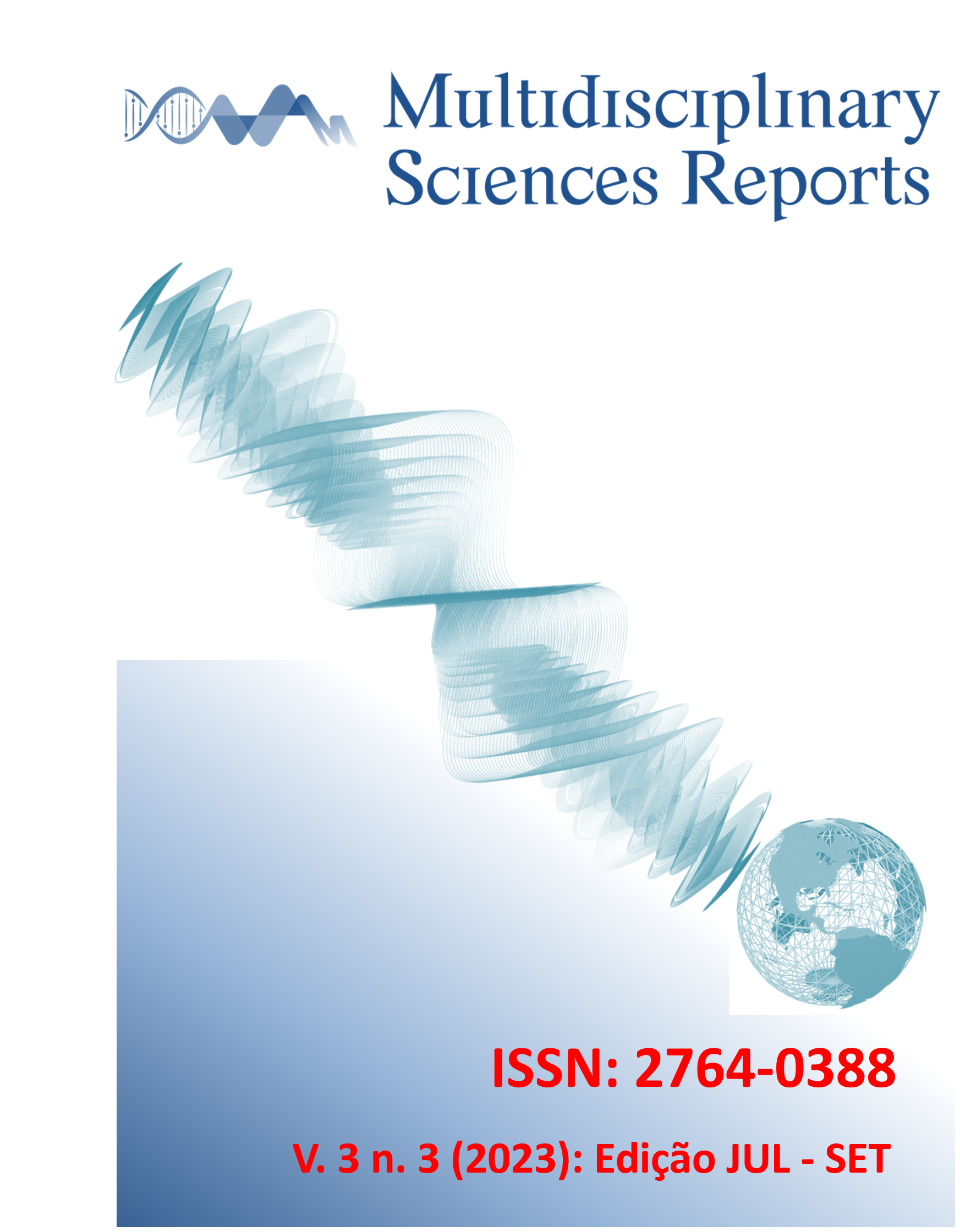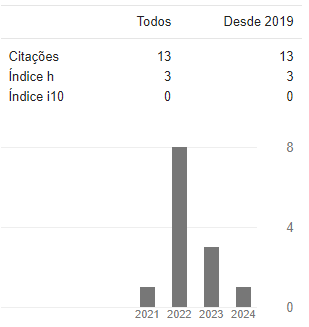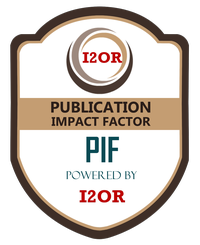IN SILICO COMPARATIVE ANALYSIS OF SARS-COV-2 MUTATIONS IN BRAZIL
Visualizações: 216DOI:
https://doi.org/10.54038/ms.v3i3.46Palavras-chave:
Coronavírus, Bioinformática, Pandemia, Proteína espícula, NextcladeResumo
SARS-CoV-2 é um novo coronavírus que surgiu no fim de 2019 na China. Ele causa Covid-19, uma doença que se tornou pandemia semanas depois do primeiro caso e é responsável por infectar e matar milhões de pessoas ao redor do mundo. Desde o primeiro surto, a comunidade científica tem procurado medidas terapêuticas e profiláticas contra a Covid-19. O objetivo desta pesquisa é trazer discussões que possam contribuir para o entendimento do vírus e o desenvolvimento de tratamentos e prevenções contra a doença, além de validar uma metodologia que possa ajudar no entendimento e controle de outros surtos virais. Para este propósito, 5016 amostras de SARS-CoV-2 coletadas no Brasil foram analisadas através de recursos computacionais. Este trabalho apresenta os resultados da árvore filogenética, entropia da informação do genoma e gráficos e tabelas mostrando informações sobre as mutações do SARS-CoV-2 no Brasil. Com base nesses resultados, evidenciou-se a importância da proteína espícula para a alta transmissibilidade do vírus.
Referências
Carvalho, T., Krammer, F., & Iwasaki, A. (2021). The first 12 months of COVID-19: a timeline of immunological insights. Nature Reviews Immunology, 21(4), 245-256. DOI: https://doi.org/10.1038/s41577-021-00522-1
Khalil, O. A. K., & da Silva Khalil, S. (2020). SARS-CoV-2: taxonomia, origem e constituição. Revista de Medicina, 99(5), 473-479. DOI: https://doi.org/10.11606/issn.1679-9836.v99i5p473-479
Arya, R., Kumari, S., Pandey, B., Mistry, H., Bihani, S. C., Das, A., ... & Kumar, M. (2021). Structural insights into SARS-CoV-2 proteins. Journal of molecular biology, 433(2), 166725. DOI: https://doi.org/10.1016/j.jmb.2020.11.024
Grudlewska-Buda, K., Wiktorczyk-Kapischke, N., Wałecka-Zacharska, E., Kwiecińska-Piróg, J., Buszko, K., Leis, K., ... & Skowron, K. (2021). SARS-CoV-2—morphology, transmission and diagnosis during pandemic, review with element of meta-analysis. Journal of Clinical Medicine, 10(9), 1962. DOI: https://doi.org/10.3390/jcm10091962
Yeh, T. Y., & Contreras, G. P. (2021). Full vaccination against COVID-19 suppresses SARS-CoV-2 delta variant and spike gene mutation frequencies and generates purifying selection pressure. Medrxiv, 2021-08. DOI: https://doi.org/10.1101/2021.08.08.21261768
Sánchez, C. M., Izeta, A., Sánchez-Morgado, J. M., Alonso, S., Sola, I., Balasch, M., ... & Enjuanes, L. (1999). Targeted recombination demonstrates that the spike gene of transmissible gastroenteritis coronavirus is a determinant of its enteric tropism and virulence. Journal of virology, 73(9), 7607-7618. DOI: https://doi.org/10.1128/JVI.73.9.7607-7618.1999
Hu, T., Li, J., Zhou, H., Li, C., Holmes, E. C., & Shi, W. (2021). Bioinformatics resources for SARS-CoV-2 discovery and surveillance. Briefings in bioinformatics, 22(2), 631-641. DOI: https://doi.org/10.1093/bib/bbaa386
Waman, V. P., Sen, N., Varadi, M., Daina, A., Wodak, S. J., Zoete, V., ... & Orengo, C. (2021). The impact of structural bioinformatics tools and resources on SARS-CoV-2 research and therapeutic strategies. Briefings in Bioinformatics, 22(2), 742-768. DOI: https://doi.org/10.1093/bib/bbaa362
Li, Y. D., Chi, W. Y., Su, J. H., Ferrall, L., Hung, C. F., & Wu, T. C. (2020). Coronavirus vaccine development: from SARS and MERS to COVID-19. Journal of biomedical science, 27(1), 1-23. DOI: https://doi.org/10.1186/s12929-020-00695-2
Pagnossa, J. P., Rodrigues, S. D. O., Oliveira, G. F. D., Adnan, M., Aljaid, M. S., Assis, I. B. D., ... & Batiha, G. E. S. (2023). COVID-19 in a Pre-Omicron Era: A Cross-Sectional Immuno-Epidemical and Genomic Evaluation. Vaccines, 11(2), 272. DOI: https://doi.org/10.3390/vaccines11020272
Cock, P. J., Antao, T., Chang, J. T., Chapman, B. A., Cox, C. J., Dalke, A., ... & De Hoon, M. J. (2009). Biopython: freely available Python tools for computational molecular biology and bioinformatics. Bioinformatics, 25(11), 1422-1423. DOI: https://doi.org/10.1093/bioinformatics/btp163
Aksamentov, I., Roemer, C., Hodcroft, E. B., & Neher, R. A. (2021). Nextclade: clade assignment, mutation calling and quality control for viral genomes. Journal of open source software, 6(67), 3773. DOI: https://doi.org/10.21105/joss.03773
Thye, A. Y. K., Law, J. W. F., Pusparajah, P., Letchumanan, V., Chan, K. G., & Lee, L. H. (2021). Emerging SARS-CoV-2 variants of concern (VOCs): an impending global crisis. Biomedicines, 9(10), 1303. DOI: https://doi.org/10.3390/biomedicines9101303
Fan, Y., Li, X., Zhang, L., Wan, S., Zhang, L., & Zhou, F. (2022). SARS-CoV-2 Omicron variant: recent progress and future perspectives. Signal transduction and targeted therapy, 7(1), 141. DOI: https://doi.org/10.1038/s41392-022-00997-x
Bai, C., & Warshel, A. (2020). Critical differences between the binding features of the spike proteins of SARS-CoV-2 and SARS-CoV. The Journal of Physical Chemistry B, 124(28), 5907-5912. DOI: https://doi.org/10.1021/acs.jpcb.0c04317
Na, W., Moon, H., & Song, D. (2021). A comprehensive review of SARS-CoV-2 genetic mutations and lessons from animal coronavirus recombination in one health perspective. Journal of Microbiology, 59, 332-340. DOI: https://doi.org/10.1007/s12275-021-0660-4
Leparc-Goffart, I., Hingley, S. T., Chua, M. M., Jiang, X., Lavi, E., & Weiss, S. R. (1997). Altered pathogenesis of a mutant of the murine coronavirus MHV-A59 is associated with a Q159L amino acid substitution in the spike protein. Virology, 239(1), 1-10. DOI: https://doi.org/10.1006/viro.1997.8877
Vinga, S. (2014). Information theory applications for biological sequence analysis. Briefings in bioinformatics, 15(3), 376-389. DOI: https://doi.org/10.1093/bib/bbt068
Ghanchi, N. K., Nasir, A., Masood, K. I., Abidi, S. H., Mahmood, S. F., Kanji, A., ... & Hasan, R. (2021). Higher entropy observed in SARS-CoV-2 genomes from the first COVID-19 wave in Pakistan. PloS one, 16(8), e0256451. DOI: https://doi.org/10.1371/journal.pone.0256451
Fan, Z., Yao, B., Ding, Y., Zhao, J., Xie, M., & Zhang, K. (2021). Entropy-driven amplified electrochemiluminescence biosensor for RdRp gene of SARS-CoV-2 detection with self-assembled DNA tetrahedron scaffolds. Biosensors and Bioelectronics, 178, 113015. DOI: https://doi.org/10.1016/j.bios.2021.113015
Sharawy, L., Tantawy, M., Ahmed, Y., Taha, A., Soliman, O., Ibrahim, T. M., & El-Hadidi, M. (2020, October). In-Silico Comparative Analysis of Egyptian SARS CoV-2 with Other Populations: a Phylogeny and Mutation Analysis. In 2020 2nd Novel Intelligent and Leading Emerging Sciences Conference (NILES) (pp. 618-622). IEEE. DOI: https://doi.org/10.1109/NILES50944.2020.9257918
Biswas, S. K., & Mudi, S. R. (2020). Spike protein D614G and RdRp P323L: the SARS-CoV-2 mutations associated with severity of COVID-19. Genomics & informatics, 18(4). DOI: https://doi.org/10.5808/GI.2020.18.4.e44
Li, M., Prasad, N., Hall, D., & Wu, H. (2020, December). Analysis of SARS-CoV-2 sequences reveals transmission path and emergence of S D 614G mutation. In 2020 IEEE International Conference on Bioinformatics and Biomedicine (BIBM) (pp. 1995-1998). IEEE. DOI: https://doi.org/10.1109/BIBM49941.2020.9313091
Zhang, J., Cai, Y., Xiao, T., Lu, J., Peng, H., Sterling, S. M., ... & Chen, B. (2021). Structural impact on SARS-CoV-2 spike protein by D614G substitution. Science, 372(6541), 525-530. DOI: https://doi.org/10.1126/science.abf2303
Velasco, J. M., Chinnawirotpisan, P., Joonlasak, K., Manasatienkij, W., Huang, A., Valderama, M. T., ... & Klungthong, C. (2020). Coding-complete genome sequences of 23 SARS-CoV-2 samples from the Philippines. Microbiology resource announcements, 9(43), e01031-20. DOI: https://doi.org/10.1128/MRA.01031-20
Downloads
- PDF (English) 106
- EPUB (English) 33
Publicado
Como Citar
Edição
Seção
Accepted 2023-08-23
Published 2023-09-03














